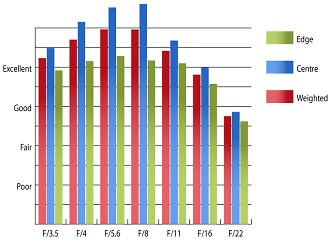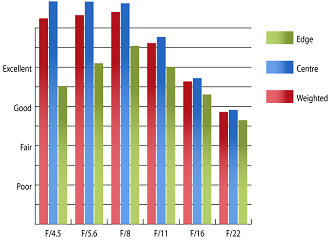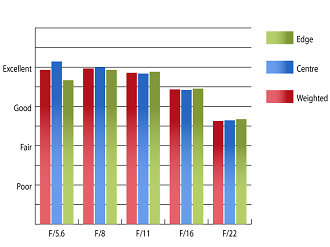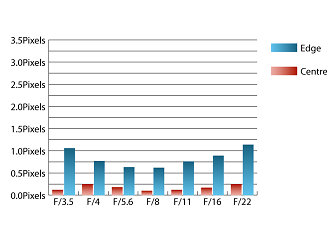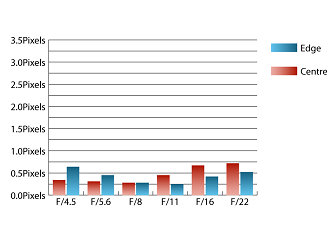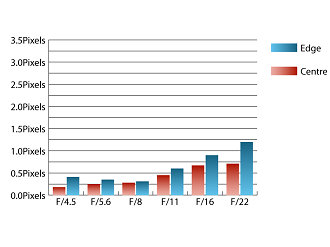HD Pentax-DA 16-85mm F3.5-5.6 ED DC WR Lens Review
HD Pentax-DA 16-85mm f/3.5-5.6 ED DC WR Performance
At 16mm, sharpness is already outstanding in the centre of the frame, with performance towards the edges falling just short of excellent levels. Stopping down to between f/5.6 and f/8 results in excellent sharpness across the frame at this focal length.
Zooming to 35mm and maximum aperture, sharpness is outstanding in the centre of the frame, with performance towards the edges of the frame falling to very good levels. Clarity in the centre remains constant between maximum aperture and f/8, with performance improving steadily to outstanding levels towards the edges of the frame.
Finally, at 85mm, sharpness remains excellent in the centre and very good towards the edges at maximum aperture. Stopping down to f/8 results in a slight improvement in sharpness towards the edges.
How to read our charts
The blue column represents readings from the centre of the picture frame at the various apertures and the green is from the edges. Averaging them out gives the red weighted column.The scale on the left side is an indication of actual image resolution. The taller the column, the better the lens performance. Simple.
For this review, the lens was tested on a Pentax K-3 using Imatest.
Chromatic aberrations are fairly well controlled with fringing just exceeding one pixel width towards the edges of the frame at 16mm and maximum aperture and stopped down to f/22 at 16mm and 85mm, which may become visible, especially in images containing areas of high contrast.
How to read our charts
Chromatic aberration is the lens' inability to focus on the sensor or film all colours of visible light at the same point. Severe chromatic aberration gives a noticeable fringing or a halo effect around sharp edges within the picture. It can be cured in software.Apochromatic lenses have special lens elements (aspheric, extra-low dispersion etc) to minimise the problem, hence they usually cost more.
For this review, the lens was tested on a Pentax K-3 using Imatest.
Falloff of illumination towards the edges is typical for a lens of this type. At 16mm and f/3.5, the corners are 1.67 stops darker than the image centre and at 85mm the corners are only 0.846 stops darker than the centre. Visually uniform illumination is achieved with the aperture stopped down to f/8 or beyond throughout the zoom range.
Distortion is also typical for this kind of lens, Imatest detected 3.65% barrel distortion at 16mm, which is replaced by 0.834% pincushion distortion at 85mm. The distortion pattern is uniform across the frame, which should make it relatively easy to apply corrections in image editing software afterwards if absolutely straight lines are necessary.
During testing, this lens proved itself very resistant to flare and contrast levels are good, even when shooting into the light. The petal-shaped hood does a decent job of shading the lens from extraneous light that may cause issues.
Value For Money
Being priced at around £499, this lens is priced roughly in line with similar offerings from other manufacturers for their own camera systems. The closest equivalent from third party manufacturers is Sigma's 17-70mm f/2.8-4, which costs around £330, this lens isn't as telephoto, or wide, but does sport a faster maximum aperture throughout the zoom range.
Add your message
Please login here or if you've not registered, you can register here. Registering is safe, quick and free.
photodo Stats
428 MTF tests
74 in-depth photodo reviews
100+ users join each day
Help the lens community by reviewing or rating a lens today via our lens search
Latest Lens Reviews
- Chinon 28mm f/2.8 Vintage Lens Review
- Canon EF 70-200mm f/4L IS II USM Lens Review
- Samyang AF 85mm f/1.4 EF Review
- Sigma 70mm f/2.8 DG Macro Art Review
- Samyang AF 24mm f/2.8 FE Review
- Meike 50mm f/1.7 Review
- Tamron 70-210mm f/4 Di VC USD Review
- Lensbaby Burnside 35mm f/2.8 Review
- Asahi Super Takumar 50mm f/1.4 Review
- Asahi Super-Multi-Coated Takumar 135mm f/3.5 Review
